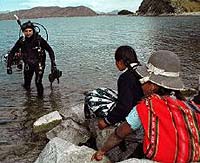| . |  |
. |
Edmonton, Canada (SPX) May 21, 2009 The study of ancient lake sediment from high altitude lakes in the Andes has revealed for the first time that mercury pollution occurred long before the start of the Industrial Revolution. University of Alberta Earth and Atmospheric Sciences PhD student Colin Cooke's results from two seasons of field work in Peru have now provided the first unambiguous records of pre-industrial mercury pollution from anywhere in the world and will be published in the May 18th Early Edition of the Proceedings of the National Academy of Sciences (PNAS). "The idea that mercury pollution was happening before the industrial revolution has long been hypothesised on the basis of historical records, but never proven," said Cooke whose research was funded by the National Geographic Society. Cooke and his team recovered sediment cores from high elevation lakes located around Huancavelica, which is the New World's largest mercury deposit. By measuring the amount of mercury preserved in the cores back through time, they were able to reconstruct the history of mercury mining and pollution in the region. "We found that mercury mining, smelting and emissions go back as far as 1400 BC," said Cooke. "More surprisingly, mining appears to have began before the rise of any complex or highly stratified society. This represents a departure from current thinking, which suggests mining only arose after these societies emerged," said Cooke. Initially, mercury pollution was in the form of mine dust, largely resulting from the production of the red pigment vermillion. "Vermillion is buried with kings and nobles, and was a paint covering gold objects buried with Andean kings and nobles," said Cooke. However, following Inca control of the mine in 1450 AD, mercury vapour began to be emitted. "This change is significant because it means that mercury pollution could be transported over much greater distances, and could have been converted into methylmercury, which is highly toxic," said Cooke. "All of these results confirm long-standing questions about the existence and magnitude pre-industrial mercury pollution, and have implications for our understanding of how mining and metallurgy evolved in the Andes," said Cooke.
Share This Article With Planet Earth
Related Links University of Alberta Our Polluted World and Cleaning It Up
 Peru-Bolivia route blocked over Titicaca pollution
Peru-Bolivia route blocked over Titicaca pollutionLa Paz (AFP) May 19, 2009 Protesters on Tuesday blocked a busy highway linking Peru and Bolivia for a second day over increased pollution in the Titicaca, the lake the two countries share, local media reported. Local residents are concerned over residues from illegal mining operations being dumped in the Titicaca, the highest navigable lake in the world, Radio Sariri reported. According to Radio Erbol, the levels ... read more |
|
| The content herein, unless otherwise known to be public domain, are Copyright 1995-2009 - SpaceDaily. AFP and UPI Wire Stories are copyright Agence France-Presse and United Press International. ESA Portal Reports are copyright European Space Agency. All NASA sourced material is public domain. Additional copyrights may apply in whole or part to other bona fide parties. Advertising does not imply endorsement,agreement or approval of any opinions, statements or information provided by SpaceDaily on any Web page published or hosted by SpaceDaily. Privacy Statement |